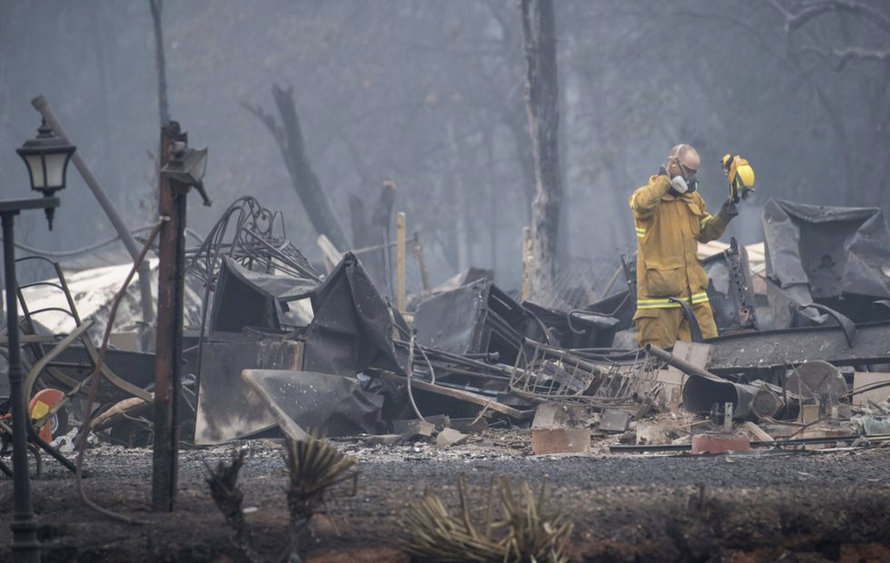Two weeks after California’s largest utility PG&E filed for bankruptcy protection (marking its second bankruptcy in 20 years), Bloomberg is sounding the alarm that California’s two other large electric utilities are just one wildfire away from bankruptcy filings of their own – a fact that was underscored last month when S&P slashed their credit ratings to near-junk status.
And to the chagrin of California residents, Gov. Gavin Newsom has done nothing to ease these anxieties, leaving large swaths of the largest state in the union without solvent utility companies (a situation that would likely lead to massive rate hikes on California’s already heavily taxed consumers).
The two utilities in question are Edison International’s Southern California Edison Co. and Sempra Energy’s San Diego Gas & Electric Co. Both utilities have begged California lawmakers to reconsider the state’s view on the legal concept of inverse condemnation. Put simply, this legal principle allows utilities to be held liable for any wildfires caused by their equipment – even if the utilities have followed every safety rule. But so far, their pleas have fallen on deaf ears (for the record, the changes being requested wouldn’t affect the distribution of liability if the utilities are found to be negligent).
“This is a really serious issue that could absolutely impair the health of utilities in this state,” Pedro Pizarro, Edison’s chief executive officer, said in an interview. “I don’t want to speculate about bankruptcy, but this is serious. And the current approach is just not sustainable.”
But as Bloomberg points out, there are several easy solutions that wouldn’t be difficult for the legislature and governor’s mansion to pursue. The legislature has the power to change the standard. But so far, they have opted to do nothing.
Here’s a rundown of the options (text courtesy of Bloomberg):
Legislation
California lawmakers spent much of last year hunting for a solution. In August, they passed a bill designed to help utilities cover liabilities from a wave of fires in 2017. But it doesn’t offer aid for 2018 fires, a critical issue after November’s Camp Fire, the deadliest in state history. With PG&E’s equipment seen as a possible ignition source, the company estimated it was facing $30 billion in wildfire liabilities when it filed for bankruptcy.
California’s new governor, Gavin Newsom, assembled an advisory panel and told them to fast-track their efforts; he wants a report before July. Utilities and legislators are all offering ideas, but there’s no guarantee they’ll find a solution that will help the power companies without becoming a financial burden to the state, or raise the ire of ratepayers and voters.
The inverse condemnation doctrine is rooted in California’s constitution, so any direct changes would require a constitutional amendment, according to the state’s legislative counsel office. An amendment would need to win two-thirds majorities in both the state Assembly and Senate, and then be approved by voters. Given the public anger at PG&E, that avenue is closed, legislators say.
“There’s no sense of anyone planning to do that, at least in the Democratic caucus,” said state Senator Jerry Hill.
New Standard
The utilities say another option is for the legislature to change the way inverse condemnation is applied. Instead of using a standard of strict liability, the state could instead look at whether the utility acted reasonably in running its equipment. There’s a precedent for this: a 1997 state Supreme Court ruling that used this standard in a water-district case.
“We’ve actually looked at this really closely, and we believe that under the law, yes, the legislature has the power to change that standard,” Pizarro said. “We’re not looking to get off the hook here if we’re negligent. If we’re negligent, we should be held accountable.”
However, utilities already pitched this idea to Sacramento last year, with no success. Lawmakers said electric utilities and water districts were too different to make this a plausible connection.
Compensation Fund
Some legislators are focusing on alternative ways to compensate fire victims, easing the financial pressure on utilities.
Assemblyman Chad Mayes in January introduced a bill to create a California Wildfire Catastrophe Fund. Utilities would pay into the fund annually, and a public authority would oversee it. The money would back bonds, and utilities could use the proceeds to settle wildfire claims.
Many of the details need to be worked out, Mayes said. Can utilities pass on some of the costs to customers? If so, how much? Should the state seed the fund with money from its greenhouse gas cap-and-trade program? Still, Sacramento is committed to resolving the issue, “because we’ve got to keep the lights on,” he said.
“The idea is to pre-fund the disaster, not post-fund the disaster,” said Mayes, a Republican representing desert communities around Palm Springs. With the law passed last year, “we tried to post-fund the disaster.”
But for some reason, the political will to safeguard the state’s utilities is virtually non-existent. And the only solution lawmakers and the state’s utility regulator have latched on to so far – at least as far as PG&E is concerned – is breaking up utilities found liable for the wildfires and bringing them under state control. And while the utilities have taken the brunt of the blame in the press, the fact remains that 95% of the state’s wildfires are caused by careless human errors, and amplified – not by factors linked to climate change – but by the state’s abysmal land-management policies.
via ZeroHedge News http://bit.ly/2TK8fks Tyler Durden
